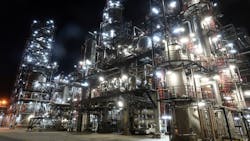Croatia’s INA lets contract for Rijeka refinery
Croatia’s INA Industrija Nafte DD—a member of MOL Group—has let a contract to a consortium of Lamor Corp. PLC and Litoclean SL for construction of a subsurface hydraulic barrier beneath the operator’s 90,000-b/d Rijeka refinery on the Urinj Peninsula, along the northern part of the Adriatic Sea.
Designed to protect the sensitive Kvarner seabed, the subsurface barrier system will intercept and prevent migration of oily contaminants from the refinery site by controlling groundwater flow toward the Adriatic Sea, Lamor said on July 15.
Construction of the barrier system will involve drilling about 50 deep boreholes beneath the refinery site, according to the service provider.
Lamor—which will begin its work on the project this summer—valued its share of the joint contract at less than €2 million.
Confirmation of the contract follows INA’s July 9 announcement of the proposed €6-million seabed remediation project at Rijeka, which will be implemented in three phases over a 2-year period for targeted completion and implementation in 2027.
INA said the project comes as part of the company’s ongoing efforts to identify a long-term solution for the remediation of historical pollution in the karst terrain beneath the Rijeka manufacturing site.
The hydraulic barrier with depressions will consist of a series of boreholes drilled along the shoreline beneath the refinery that will create an artificial underground depression—the lowest point in the subsurface—to enable controlled fluid collection and prevent migration towards the sea, forming the foundation of the operator’s entire marine protection program.
According to INA, the project’s first phase will include drilling five pilot boreholes to be used for detailed fluid-movement analyses.
Following a second phase involving construction of the remaining boreholes as well as design and redaction of the hydraulic barrier project, the project’s third and final phase will entail installation of all necessary equipment for startup of the extraction process, the operator said.
INA said it expects full implementation of the project in 2027 will provide a permanent solution to historical pollution at the Rijeka site.
Additional measures
Alongside development of the permanent subsurface hydraulic barrier solution, INA said it is also implementing several short- and medium-term measures aimed at protecting the sea and preventing active leakage at Rijeka.
To date, 33 boreholes are already operational at the site, with an additional 40 boreholes planned for drilling by yearend 2026, according to the operator.
Of the existing 33 boreholes, those used for hydrocarbon extraction remain active and direct their contents to treatment, while those containing water are used for monitoring to ensure nothing reaches the sea, INA said.
To mitigate impacts of the geologically complex terrain beneath the refinery—which has been historically contaminated over decades and is further destabilized by natural phenomena such as earthquakes and extreme tides—INA said it has installed ocean barriers that adapt to tidal changes.
While the permitting process for installation of the ocean barriers remains under way, INA experts and independent specialists currently analyze and monitor all extracted subsurface materials daily in a laboratory to distinguish between historical and new contamination, the operator said.
“We have coexisted with the local community for decades, and our goal is to ensure that the [Rijeka] refinery continues to operate—but in a more sustainable way,” said Goran Pleše, INA’s operating director of refining and marketing.
Rijeka’s seabed remediation project comes amid INA’s ongoing modernization program at the refinery, which the operator said in its latest annual report was 92.2% completed as of yearend 2024 (OGJ Online, June 29, 2020).
The entirety of the Rijeka refinery upgrade project is currently scheduled to achieve full mechanical completion during second-half 2025, INA said.
About the Author
Robert Brelsford
Downstream Editor
Robert Brelsford joined Oil & Gas Journal in October 2013 as downstream technology editor after 8 years as a crude oil price and news reporter on spot crude transactions at the US Gulf Coast, West Coast, Canadian, and Latin American markets. He holds a BA (2000) in English from Rice University and an MS (2003) in education and social policy from Northwestern University.

